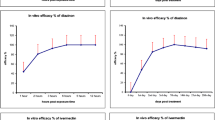Abstract
Ticks are known to be able to transmit a broad spectrum of agents of diseases in cattle or sheep. Therefore, measurements are needed to keep ticks away from the body of any ruminant belonging to the agricultural life stock. The present study dealt with investigations to measure the efficacy of the insecticide deltamethrin (Butox® 7.5 pour on) against specimens of two important species (Ixodes ricinus and Rhipicephalus sanguineus). Four sheep and four young cattle were treated lege arte along the vertebral column with 10 ml Butox® (deltamethrin) per sheep or 30 ml Butox® per cattle. Day 7, 14, 21, and 28 after the treatment, hair was shaved off from the head, ears, the back, belly, and the feet being collected in separate, suitable plastic bags, and transported to the institute, where these hair were brought into close contact with either adult and/or nymph stages of I. ricinus and R. sanguineus. As results, strong, acaricidal effects were seen, which varied according to the parasite species, the origin of the hair (e.g., head, leg, etc.) and according to the period after the treatment. In sheep, the acaricidal effect was noted for the whole period of 28 days along the whole body with respect to adults and nymphs of I. ricinus, while the acaricidal effects of deltamethrin were reduced for R. sanguineus stages beginning at day 21 after treatment. In cattle, the full acaricidal effect was seen for 21 days in I. ricinus stages and for 14 days in R. sanguineus, while the acaricidal efficacy became reduced after these periods of full action—beginning at the hair taken from the legs. Only R. sanguineus adults did not show any reaction on day 28 after treatment. Besides these acaricidal effects, repellent effects were also noted. Full repellency for both species was seen during the first 14 days in sheep and cattle against Ixodes and Rhipicephalus, while the repellency was later reduced, especially in contact with hair from the legs. As conclusion, deltamethrin, besides its very good effects against biting insects, brings acaricidal as well as repellent effects against ticks, thus protecting the sheep and cattle from transmission of agents of diseases.
Similar content being viewed by others
References
Aspöck H, Dobler JF (2008) In: Mehlhorn H (ed) Encyclopedia of parasitology, 3rd edn. Springer, Heidelberg
Eckert J, Friedhoff KT, Zahner H, Deplazes P (2008) Lehrbuch der parasitologie für die Tiermedizin. Enke, Stuttgart
Lane RP, Crosskey RW (1993) Medical insects and arachnids. Chapman & Hall, London
Liebisch G, Liebisch A (2008) Efficacy of Flectron®-eartags (cypermethrin) for control of midges (Culicoides), the vectors of bluetongue virus in cattle: field studies and bioassays. Dtsch Tieraerztl Wochenschr 115:220–230
Liebisch A, Liebisch G, Heine S, Thienel S, Hinrichs P (2008a) Wirksamkeit von Auriplak® Ohrclips (Permethrin) gegen Gnitzen (Culicoides) bei Rindern. Prakt Tierarzt 89:128–141
Liebisch G, Krieger K, Heine S, Thienel S, Hinrichs P, Liebisch A (2008b) Bayofly pour-on (cyfluthrin) bei der Abwehr und Bekämpfung von Gnitzen (Ceratopogonidae). Prakt Tierarzt 89:411–426
Mehlhorn H (ed) (2008) Encyclopedia of parasitology, 3rd edn. Springer, Heidelberg
Mehlhorn B, Mehlhorn H (2009) Zecken auf dem Vormarsch. Düsseldorf University Press, Düsseldorf
Mehlhorn H, Schein E (1984) Piroplasms: life cycle and sexual stages. Adv Parasitol 23:37–104
Mehlhorn H, Düwel D, Raether W (1993) Diagnose und Therapie der Parasitosen der Haus-, Heim- und Nutztiere, 2nd edn. G. Fischer, Stuttgart
Mehlhorn H, Walldorf V, Klimpel S, Jahn B, Jaeger F, Eschweiler J, Hoffmann B, Beer M (2007) First occurrence of Culicoides obsoletus transmitted bluetongue virus epidemic in Central Europe. Parasitol Res 101:219–228
Mehlhorn H, Schmahl G, D’Haese J, Schumacher B (2008a) Butox® 7.5 pour-on: a deltamethrin treatment of sheep and cattle: pilot study of killing effects on Culicoides species. Parasitol Res 102:515–518
Mehlhorn H, Schmahl G, Schumacher B, D’Haese J, Walldorf V, Klimpel S (2008b) Effects of Bayofly™ on specimens of Culicoides species when incubated in hair taken from the feet of previously treated cattle and sheep. Parasitol Res 102:519–522
Mehlhorn H, Walldorf V, Klimpel S (2009) Bluetongue diseases in Germany: monitoring of entomological aspects. Parasitol Res 105:321–329
Mehlhorn H, Al-Rasheid KAS, Abdel-Ghaffar KS, Pohle H (2010) Life cycle and attacks of ectoparasites on ruminants during the year in Central Europe: recommendations for treatment with insecticides (e.g. Butox®). Parasitol Res 107:425–431
Schmahl G, Walldorf V, Klimpel S, Al-Quraishy S, Mehlhorn H (2008a) Efficacy of Oyxfly™ on Culicoides species—the vectors of Bluetongue virus—and other insects. Parasitol Res 103:1101–1103
Schmahl G, Walldorf V, Klimpel S, Al-Quraishy S, Schumacher B, Jatzlau A, Mehlhorn H (2008b) Pilot study on deltamethrin treatment (Butox®7.5, Versatrine®) of cattle and sheep against midges (Culicoides species, Ceratopogonidae). Parasitol Res 104:809–813
Schmahl G, Mehlhorn H, Abdel-Ghaffar F, Al-Rasheid K, Schumacher B, Jatzlau A, Pohle H (2009a) Does rain reduce the efficacy of Butox® 7.5 pour on (deltamethrin) against biting midges (Culicoides specimens)? Parasitol Res 105:1763–1765
Schmahl G, Klimpel S, Walldorf V, Schumacher B, Jatzlau A, Al-Quraishy S, Mehlhorn H (2009b) Effects of permethrin (Flypor®) and fenvalerate (Acadrex ®60, Arkofly®) on Culicoides species—the vector of bluetongue virus. Parasitol Res 108:815–820
Semmler M, Abdel-Ghaffar F, Al-Rasheid K, Mehlhorn H (2009) Nature helps: from research to products against blood-sucking arthropods. Parasitol Res 105:1483–1487
Sonenshine WT (1991, 1992) Ticks, vol 1, 2. Academic, London
Turberg A, Hansen O (2008) Acaricides and insecticides. In: Mehlhorn H (ed) Encyclopedia of parasitology, 3rd edn. Springer, Heidelberg
Acknowledgment
We hereby gratefully acknowledge the support of this study to the Center of Excellence at the College of Science of the King Saud University in Riyadh, Saudi Arabia.
Author information
Authors and Affiliations
Corresponding author
Rights and permissions
About this article
Cite this article
Mehlhorn, H., Schumacher, B., Jatzlau, A. et al. Efficacy of deltamethrin (Butox® 7.5 pour on) against nymphs and adults of ticks (Ixodes ricinus, Rhipicephalus sanguineus) in treated hair of cattle and sheep. Parasitol Res 108, 963–971 (2011). https://doi.org/10.1007/s00436-010-2141-2
Received:
Accepted:
Published:
Issue Date:
DOI: https://doi.org/10.1007/s00436-010-2141-2




